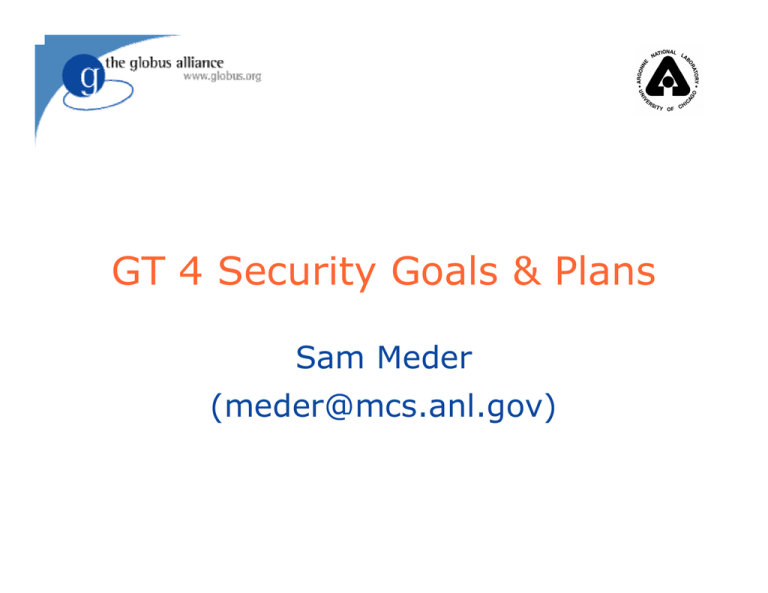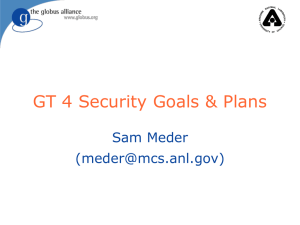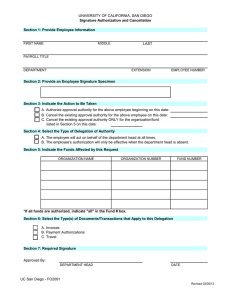GT 4 Security Goals & Plans Sam Meder ()
advertisement

GT 4 Security Goals & Plans Sam Meder (meder@mcs.anl.gov) The Ultimate Goal Enable secure cross-organizational interactions z Least privilege rights delegation z Support for multiple mechanisms -> translation z Virtual Organization security fabric z … Membership Policy etc Multi-Institution Issues No Cross- Domain Trust Certification Authority Certification Authority Domain B Domain A Trust Mismatch Policy Authority Policy Authority Task Server X Sub-Domain A1 Mechanism Mismatch Server Y Sub-Domain B1 Why Grid Security is Hard z Resources being used may be valuable & the problems being solved sensitive z Dynamic formation and management of virtual organizations (VOs) z Both users and resources need to be careful Large, dynamic, unpredictable… VO Resources and users are often located in distinct administrative domains Can’t assume cross-organizational trust agreements Different mechanisms & credentials z z X.509 vs Kerberos, SSL vs GSSAPI, X.509 vs. X.509 (different domains), X.509 attribute certs vs SAML assertions Why Grid Security is Hard… z Interactions are not just client/server, but service-to-service on behalf of the user z z Standardization of interfaces to allow for discovery, negotiation and use Implementation must be broadly available & applicable z Standard, well-tested, well-understood protocols; integrated with wide variety of tools Policy from sites, VO, users need to be combined z Requires delegation of rights by user to service Services may be dynamically instantiated Varying formats Want to hide as much as possible from applications! The Grid Trust solution z z Instead of setting up trust relationships at the organizational level (lots of overhead, possible legalities - expensive!) set up trust at the user/resource level Virtual Organizations (VOs) for multi-user collaborations Federate through mutually trusted services Local policy authorities rule z Users able to set up dynamic trust domains Personal collection of resources working together based on trust of user Grid Solution: Use Virtual Organization as Bridge No CrossDomain Trust Certification Authority Certification Authority Policy Authority Policy Authority Sub-Domain B1 Sub-Domain A1 Domain A Domain B Task Federation Service GSI Server X Virtual Organization Domain Server Y Effective Policy Governing Access Within A Collaboration Use Delegation to Establish Dynamic Distributed System Compute Center Service Rights VO Compute Center Goal is to do this with arbitrary mechanisms Compute Center X.509 AC X.509/SSL X.509 AC Service SAML Attribute Kerberos/ WS-Security Rights VO SAML Attribute Compute Center Security of Grid Brokering Services Compute Facility Raw Data Data Source Input Data Bandwidth Svc Compute Facility Svc Data Src Svc Output Data Scheduling Svc Bandwidth Svc Requester • It is expected brokers will handle resource coordination for users • Each Organization enforces its own access policy • User needs to delegate rights to broker which may need to delegate to services •QoS/QoP Negotiation and multi-level delegation Svc X Result Data Post-Processing Facility Propagation of Requester’s Rights through Job Scheduling and Submission Process Virtualization complicates Least Privilege Delegation of Rights Compute Resource Only compute cluster ABC Scheduler Dynamically limit the Delegated Rights more as Job specifics become clear Only NCSA resources Scheduler Only DOE approved sites Scheduler Requester All User's Rights & Capabilities Trust parties downstream to limit rights for you… or let them come back with job specifics such that you can limit them Grid Security must address… z z Trust between resources without organization support Bridging differences between mechanisms z Allow for controlled sharing of resources z Delegation from site to VO Allow for coordination of shared resources z Authentication, assertions, policy… Delegation from VO to users, users to resources ...all with dynamic, distributed user communities and least privilege. Functional Capabilities w w w w Authentication service: An authentication service is concerned with verifying proof of an asserted identity. Identity mapping service: The identity mapping service provides the capability of transforming an identity that exists in one identity domain into a identity within another identity domain. Authorization service: The authorization service is concerned with resolving a policy based access control decision. Credential Conversion service: The credential conversion service provides credential conversion between one type of credential to another type or form of credential. w w w w w Audit service: The audit service is responsible for producing records, which track security relevant events. Profile service: The profile service is concerned with managing service requestor’s preferences and data which may not be directly consumed by the authorization service. Privacy service: The privacy service is primarily concerned with the policy driven classification of personally identifiable information (PII). VO Policy service: The VO policy service is concerned with the management of policies. … Security Components Intrusion Detection Secure Conversations Credential and Identity Translation (Single Logon) Access Control Enforcement Audit & Non-repudiation Anti-virus Management Authorization Policy Policy Expression and Exchange User Management Key Management Bindings Security (transport, protocol, message security) Privacy Policy Secure Logging (authorization, privacy, federation, etc) Mapping Rules Trust Model Policy Management Service/End-point Policy Grid Security Services call-outs Requestor's Domain Attribute Service Trust Service Audit/ Secure-Logging Service Service Provider's Domain Authorization Service Authorization Service Privacy Service Trust Service Attribute Service Audit/ Secure-Logging Service Privacy Service Credential Validation Service Credential Validation Service Bridge/ Translation Service Requestor Application WS-Stub Secure Conversation VO Domain WS-Stub Service Provider Application Grid Security Services with VO Requestor's Domain Attribute Service Trust Service Audit/ Secure-Logging Service Service Provider's Domain Authorization Service Authorization Service Privacy Service Trust Service Attribute Service Audit/ Secure-Logging Service Privacy Service Credential Validation Service Credential Validation Service Bridge/ Translation Service Requestor Application WS-Stub Credential Validation Service Secure Conversation Trust Service VO Domain Authorization Service WS-Stub Attribute Service Service Provider Application Interaction with other Grid Services z All Grid services layered on Security Services All z interactions are subject to policy enforcement Grid Security Services leverage other Services Use of registries/databases/QoS/discovery/migration/ meta-data-publication/fail-over/mirroring/provisioning/etc. z Security Policy derived from higher level agreements Enforcement z is means to meet “business” objectives New agreements subject to governing security policy existing access restriction override any new agreement Security Services can not be seen in isolation! GT 4 (3.9.2) Existing Features z Authentication GSI Secure Message z Based on earlier WS-Security draft z Support for signing and encrypting using X.509 certificates and X.509 Proxy Certificates z Per message GSI Secure Conversation z Based on proprietary protocol (predates WSSecureConversation) z GSSAPI z SSL + delegation + proxy cetificates (Kerberos) Session based GT 4 (3.9.2) Existing Features z Authorization Host Self Identity Gridmap Custom GT 4 Plans-Authentication z z Move to WSS4J Web Services Security 1.0 WS-I Basic Security Profile Support for Username/Password Move to WS-Trust/WS-SecureConversation z z Make GSI-Secure Conversation compliant with latest drafts (Introduce secure Username/Password session protocol (based on AuthA)) (https – XML Security performance…) GT 4 Plans - Delegation z Delegation Service Using WSRF z Delegated credentials modeled as resources z Lifetime management using WS-ResourceLifetime Allows decoupling of delegation from authentication No problem with WS-I Basic Security Profile Pushes delegation handling to application level z Requires modification of application protocol GT 4 Plans - Authorization z z CAS WSRF port Integration of new authorization framework developed at KTH XACML engine Management interface Chaining of authorization decisions Per method granularity GT 4 Plans – Authorization (cont.) z z Port of SAML authorization callout Based on work in OGSA Authz WG Requires schema for resource id CAS enabled grid services Integration of SAML based CAS assertions with XACML engine Will lead to generic SAML/XACML delegation of rights framework GT 4 Plans - MyProxy z Inclusion of MyProxy Non-WS to begin with



